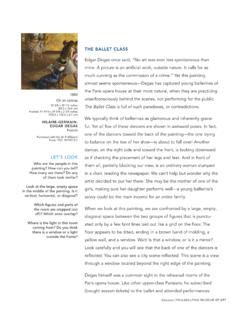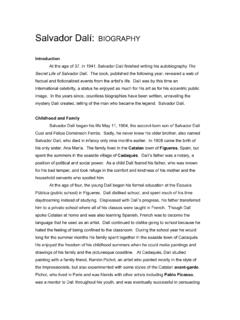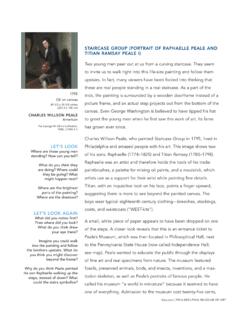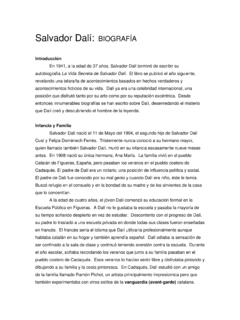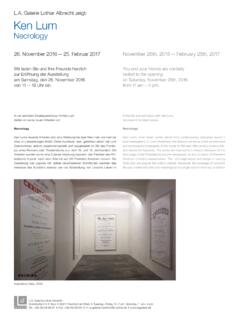Transcription of Digging Deep Elements of Art - Philadelphia Museum of Art
1 For more information, please contact Division of Education and Public Programs: School and Teacher Programs by phone at 215-684-7580, by fax at 215-236-4063, or by e-mail at LINE, COLOR, SPACE, LIGHT, AND SHAPE: WHAT DO THEY DO? WHAT DO THEY EVOKE? Good composition is like a suspension bridge; each line adds strength and takes none Making lines run into each other is not composition. There must be motive for the connection. Get the art of controlling the observer that is composition. Robert Henri, American painter and teacher The Elements and principals of art and design, and how they are used, contribute mightily to the ultimate composition of a work of art and that can mean the difference between a masterpiece and a messterpiece.
2 Just like a reader who studies vocabulary and sentence structure to become fluent and present within a compelling story, an art appreciator who examines line, color, space, light, and shape and their roles in a given work of art will be able to stand with the artist and think about how they made the artwork work. In this activity, students will practice looking for design Elements in works of art , and learn to describe and discuss how these Elements are used in artistic compositions. Grade Level Grades 4 12 Common Core Academic Standards and and National Visual Arts Standards Artistic Process: Responding: Understanding and evaluating how the arts convey meaning Art Images Required NOTE: Any image will work for this activity.
3 Click on the title below to view a high-resolution photograph on the Philadelphia Museum of art website. This image is also available in the Artstor Digital Library. Enter the provided search phrase into the Artstor search bar to view the corresponding image in that database. Still Life with a Ham and a Roemer, c. 1631 34, by Willem Claesz Heda Artstor search: PMA Cat. 644 Still Life with a Ham and a Roemer, c. 1631 34 Willem Claesz. Heda, Dutch Oil on panel 23 1/4 x 32 1/2 inches (59 x cm) John G. Johnson Collection, 1917 Cat.
4 644 For more information, please contact Division of Education and Public Programs: School and Teacher Programs by phone at 215-684-7580, by fax at 215-236-4063, or by e-mail at Materials Required Elements Information Handout (attached) Lesson Process 1. Introduce the idea of looking for design Elements (line, color, space, light, and shape) in a work of art as an approach to understanding a painting, sculpture, or decorative art. Encourage students to consider that behind every picture of a person, landscape, or still life, the artist has thought about how these Elements work together to create the composition.
5 2. Give each student a printout of the attached Elements Information Handout. 3. Display the painting Still Life with a Ham and a Roemer. Ask students to look carefully at the work and notice what Elements of design they see. Have them choose one element to focus on and, after reading the handout, describe how that element works in the painting. Have them respond: How does it impact your reaction to the work? 4. Have students choose a second element and repeat the process. 5. Discuss student observations as a group. Reflect on their observations and thinking by answering the following questions: What new ideas do you have about the work of art ?
6 What did you see that you didn t see before? What more do you want to know? Assessment 1. During group sharing, students will discuss where the Elements they chose to focus on are used in the work of art and how those Elements contribute to the composition. 2. Students should write a brief reaction paper, describing what they now see that they did not before and what new ideas they have about the selected work of art . Enrichment 1. Have students look for other works of art that use the Elements that they focused on in both similar and different ways from the work of art they just observed.
7 Use a Venn diagram to compare similarities and differences, but keep the observations focused only on the Elements . 2. Have students select one of the Elements of art and create a sketch based on their understanding of that element. For more information, please contact Division of Education and Public Programs: School and Teacher Programs by phone at 215-684-7580, by fax at 215-236-4063, or by e-mail at Elements INFORMATION HANDOUT Digging Deep with the Elements : Line, Color, Space, Light, and Shape Line is a continuous mark with a greater length than width.
8 Actual lines can define the edge of a form. Implied lines can lead your eye into and through the composition and provide information about character and action. Possible characteristics: horizontal, vertical, diagonal, zigzag, curvy, thick, thin, straight, curved, directional, one-dimensional, pathfinding, suggesting movement, broken, angular, loopy. Horizontal lines: allude to repose. Vertical lines: allude to strength and power. Diagonal lines: allude to dynamic movement. Color is perceived as the light reflected off of objects and has three main characteristics hue, value, and intensity.
9 Possible characteristics: warm/cool palette, subdued, brilliant, dazzling, sizzling, vibrant, dull, chilly, refracted, pure, soft, muddy, coordinated, tertiary, intensity, pigment, color wheel, spectrum, monochromatic, diluted, natural, chemical, pastel, contrasting. Primary colors: yellow, red, and blue. Secondary colors: orange, purple, and green. Complementary colors: are opposite each other on the color wheel: yellow/purple; red/green; blue/orange. Space is the area between and around an object; real space is three-dimensional. Space can also refer to the two-dimensional illusion of depth.
10 Possible characteristics: perspective, foreground, middle ground, background, shallow, deep, wide, realistic, abstract, primary, inner, outer, deep, white space, picture plane. Positive space: the space the object occupies. Negative space: space between the edge of the positive space and the frame. Light often describes the light source or light reflected within the composition. In realistic compositions, if there is light, there is shadow. Possible characteristics: chiaroscuro, brilliant, bright, dark, shadows, shade, holy light, night light, moonlight, sunlight, bulbs, morning light, dusk, diffused, dim, filtered, illuminated, clear, highlights, foggy, mystical, realistic, imaginary.
